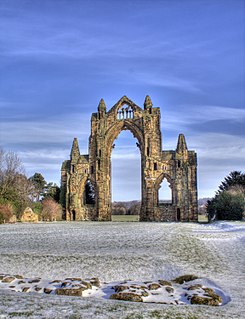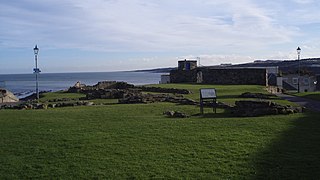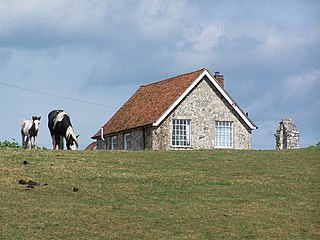
Gisborough Priory is a ruined Augustinian priory in Guisborough in the current borough of Redcar and Cleveland, historic North Riding of Yorkshire, England. It was founded in 1119 as the Priory of St Mary by the Norman feudal magnate Robert de Brus, also an ancestor of the Scottish king, Robert the Bruce. It became one of the richest monastic foundations in England with grants from the crown and bequests from de Brus, other nobles and gentry and local people of more modest means. Much of the Romanesque Norman priory was destroyed in a fire in 1289. It was rebuilt in the Gothic style on a grander scale over the following century. Its remains are regarded as among the finest surviving examples of early Gothic architecture in England.

Nostell Priory is a Palladian house located in Nostell, near Crofton close to Wakefield, West Yorkshire, England, approached by the Doncaster road from Wakefield. It dates from 1733, and was built for the Winn family on the site of a medieval priory. The Priory and its contents were given to the National Trust in 1953 by the trustees of the estate and Rowland Winn, 3rd Baron St Oswald.

Our Lady of Walsingham is a title of the Blessed Virgin Mary venerated by Roman Catholics, Western Rite Orthodox Christians, and some Anglicans associated with the Marian apparitions to Richeldis de Faverches, a pious English noblewoman, in 1061 in the village of Walsingham in Norfolk, England. Lady Richeldis had a structure built named "The Holy House" in Walsingham which later became a shrine and place of pilgrimage.

Leiston Abbey in Suffolk, England, was a religious house of Canons Regular following the Premonstratensian rule, dedicated to St. Mary. Founded in c. 1183 by Ranulf de Glanville, Chief Justiciar to King Henry II (1180-1189), it was originally built on a marshland isle near the sea, and was called "St Mary de Insula". Around 1363 the abbey suffered so much from flooding that a new site was chosen and it was rebuilt further inland for its patron, Robert de Ufford, 1st Earl of Suffolk (1298-1369). However, there was a great fire in c. 1379 and further rebuilding was necessary.

Barlings Abbey, Lincolnshire, was a Premonstratensian monastery in England, founded in 1154, as a daughter house of the Abbey of St. Mary and St. Martial in Newsham.

The Priory Church of St Mary and St Hardulph is the Church of England parish church of Breedon on the Hill, Leicestershire, England. The church has also been known as Breedon Priory and as the Holy Hill Monastery.

St John's Abbey, also called Colchester Abbey, was a Benedictine monastic institution in Colchester, Essex, founded in 1095. It was dissolved in 1539.
Æthelwold was the first Bishop of Carlisle in medieval England.

Bradenstoke Priory was a medieval priory of Augustinian canons regular in the village of Bradenstoke, Wiltshire, England. Its site, in the north of the county about 1 1⁄2 miles (2.4 km) west of Lyneham, is on a ridge above the south side of Dauntsey Vale. In the 1930s the property was purchased by William Randolph Hearst and some of its structures were used by him for the renovation of St Donat's Castle near Llantwit Major, Wales.

The Church of St Mary on the Rock or St Mary's Collegiate Church, was a secular college of priests based on the seaward side of St Andrews Cathedral, St Andrews, just beyond the precinct walls. It is known by a variety of other names, such as St Mary of the Culdees, Kirkheugh and Church of St Mary of Kilrymont.

St Oswald's Priory was founded by Æthelflæd, daughter of Alfred the Great, and her husband Æthelred, ealdorman of Mercia, in the late 880s or the 890s.

Alvingham Priory was a Gilbertine priory in St. Mary, Alvingham, Lincolnshire, England. The Priory, established between 1148 and 1154, was a "double house", where religious of both sexes lived in two separate monasteries. They did not commonly communicate with one another, and there was an internal wall dividing their priory church. The superior of every Gilbertine house was the prioress, the prior being really an official of her house.

Bullington Priory was a priory in Bullington, Lincolnshire, England.

St. Mary Magdalen was a Benedictine priory in Lincoln, England. Along with Sandtoft Priory and Hanes Cell, it was a Lincolnshire cell of St Mary's Abbey in York, England. A surviving building, once owned by the priory, is Monks' Abbey, Lincoln.
Blythburgh Priory was a medieval monastic house of Augustinian canons, dedicated to the Blessed Virgin Mary, located in the village of Blythburgh in Suffolk, England. Founded in the early 12th century, it was among the first Augustinian houses in England and began as a cell of St Osyth's Priory in Essex. Although it acquired a conventual life of its own, its community was always small and in some respects maintained dependency upon the parent house. It was earmarked for closure by Cardinal Wolsey during the late 1520s but survived his fall and continued until dissolution in 1536.

Butley Priory, sometimes called Butley Abbey, was a religious house of Canons regular in Butley, Suffolk, dedicated to The Blessed Virgin Mary. It was founded in 1171 by Ranulf de Glanville, Chief Justiciar to King Henry II (1180-1189), and was the sister foundation to Ranulf's house of White canons (Premonstratensians) at Leiston Abbey, a few miles to the north, founded c. 1183. Butley Priory was suppressed in 1538.

Ivychurch Priory was a medieval monastic house in Alderbury, southeast of Salisbury, Wiltshire, England. According to Historic England, "all that remains is a cylindrical pier with multi-scalloped capital and part of the double-chamfered arch with a respond to the west with a half-pier and capital; this is attached to the west wall of the church which retains one buttress".

Hirst Priory is an history 18th century country house and grounds in Belton on the Isle of AxholmeNorth Lincolnshire, United Kingdom. The current building was built upon the site of a 12th-century Augustinian priory,.
Stoke-by-Clare Priory was a Benedictine monastery in Stoke-by-Clare, in Suffolk, an alien priory, dependent on Bec Abbey, in Normandy. Reinstituted in 1124, the Priory was suppressed in 1415.
















